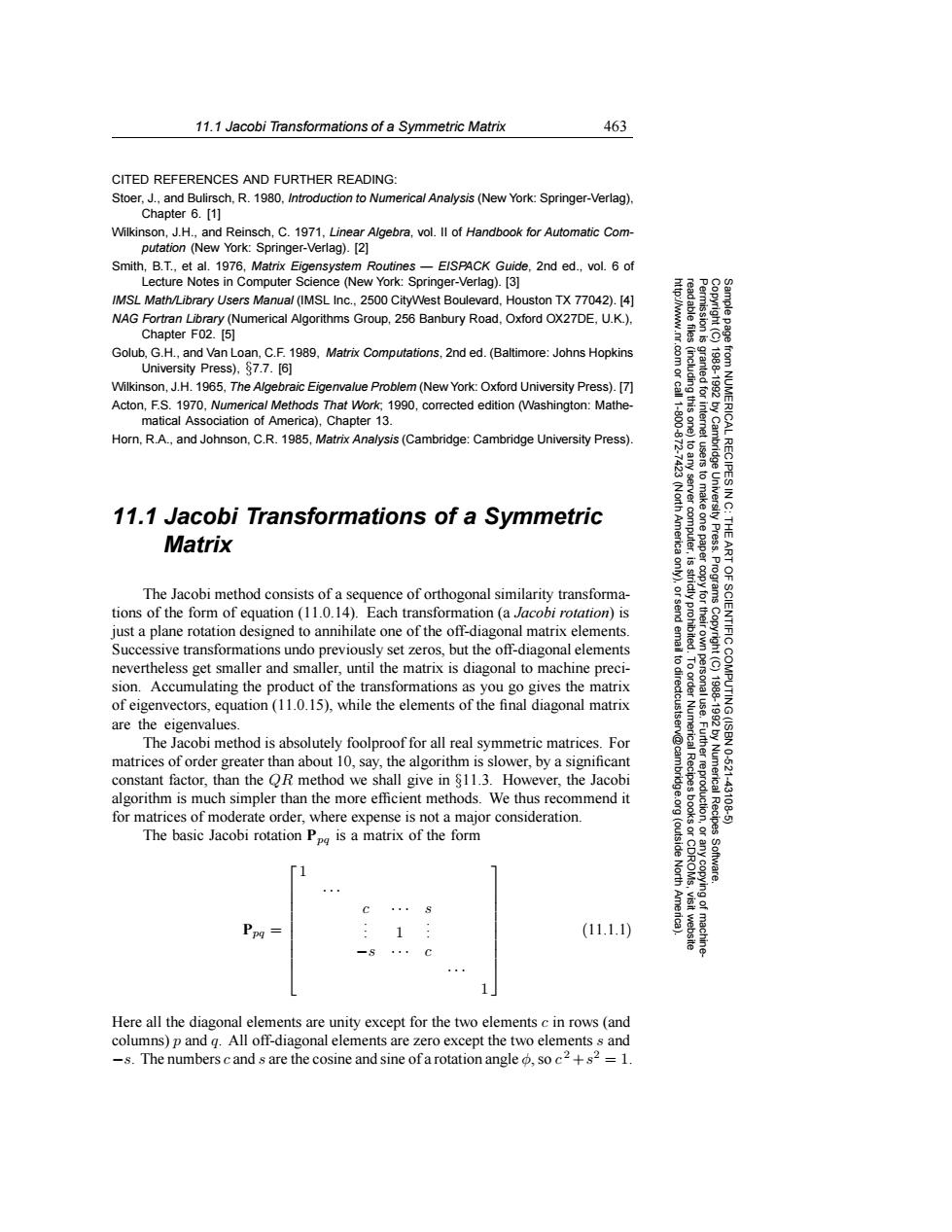正在加载图片...

11.1 Jacobi Transformations of a Symmetric Matrix 463 CITED REFERENCES AND FURTHER READING: Stoer,J.,and Bulirsch,R.1980,Introduction to Numerical Analysis(New York:Springer-Verlag). Chapter 6.[1] Wilkinson,J.H.,and Reinsch,C.1971,Linear Algebra,vol.ll of Handbook for Automatic Com- putation (New York:Springer-Verlag).[2] Smith,B.T.,et al.1976,Matrix Eigensystem Routines-EISPACK Guide,2nd ed.,vol.6 of Lecture Notes in Computer Science (New York:Springer-Verlag).[3] IMSL Math/Library Users Manual (IMSL Inc.,2500 CityWest Boulevard,Houston TX 77042).[4] NAG Fortran Library (Numerical Algorithms Group,256 Banbury Road,Oxford OX27DE,U.K.). Chapter F02.[5] Golub,G.H.,and Van Loan,C.F.1989,Matrix Computations,2nd ed.(Baltimore:Johns Hopkins University Press),87.7.[6] Wilkinson,J.H.1965,The Algebraic Eigenvalue Problem(New York:Oxford University Press).[7] Acton,F.S.1970,Numerica/Methods That Work;1990,corrected edition (Washington:Mathe- matical Association of America),Chapter 13. 骨家 Horn,R.A.,and Johnson,C.R.1985,Matrix Analysis(Cambridge:Cambridge University Press). RECIPES 11.1 Jacobi Transformations of a Symmetric Matrix 县% 令 The Jacobi method consists of a sequence of orthogonal similarity transforma- tions of the form of equation (11.0.14).Each transformation (a Jacobi rotation)is just a plane rotation designed to annihilate one of the off-diagonal matrix elements. 家 SCIENTIFIC Successive transformations undo previously set zeros,but the off-diagonal elements nevertheless get smaller and smaller,until the matrix is diagonal to machine preci- 可 sion.Accumulating the product of the transformations as you go gives the matrix of eigenvectors,equation(11.0.15),while the elements of the final diagonal matrix are the eigenvalues. The Jacobi method is absolutely foolproof for all real symmetric matrices.For matrices of order greater than about 10,say,the algorithm is slower,by a significant 10.621 constant factor,than the OR method we shall give in $11.3.However,the Jacobi algorithm is much simpler than the more efficient methods.We thus recommend it E喜 Numerical Recipes 43106 for matrices of moderate order,where expense is not a major consideration. The basic Jacobi rotation Pp is a matrix of the form (outside North Software. c (11.1.1) Here all the diagonal elements are unity except for the two elements c in rows (and columns)p and g.All off-diagonal elements are zero except the two elements s and -s.The numbers c and s are the cosine and sine of a rotation angle o,so c2+s2 =1.11.1 Jacobi Transformations of a Symmetric Matrix 463 Permission is granted for internet users to make one paper copy for their own personal use. Further reproduction, or any copyin Copyright (C) 1988-1992 by Cambridge University Press. Programs Copyright (C) 1988-1992 by Numerical Recipes Software. Sample page from NUMERICAL RECIPES IN C: THE ART OF SCIENTIFIC COMPUTING (ISBN 0-521-43108-5) g of machinereadable files (including this one) to any server computer, is strictly prohibited. To order Numerical Recipes books or CDROMs, visit website http://www.nr.com or call 1-800-872-7423 (North America only), or send email to directcustserv@cambridge.org (outside North America). CITED REFERENCES AND FURTHER READING: Stoer, J., and Bulirsch, R. 1980, Introduction to Numerical Analysis (New York: Springer-Verlag), Chapter 6. [1] Wilkinson, J.H., and Reinsch, C. 1971, Linear Algebra, vol. II of Handbook for Automatic Computation (New York: Springer-Verlag). [2] Smith, B.T., et al. 1976, Matrix Eigensystem Routines — EISPACK Guide, 2nd ed., vol. 6 of Lecture Notes in Computer Science (New York: Springer-Verlag). [3] IMSL Math/Library Users Manual (IMSL Inc., 2500 CityWest Boulevard, Houston TX 77042). [4] NAG Fortran Library (Numerical Algorithms Group, 256 Banbury Road, Oxford OX27DE, U.K.), Chapter F02. [5] Golub, G.H., and Van Loan, C.F. 1989, Matrix Computations, 2nd ed. (Baltimore: Johns Hopkins University Press), §7.7. [6] Wilkinson, J.H. 1965, The Algebraic Eigenvalue Problem (New York: Oxford University Press). [7] Acton, F.S. 1970, Numerical Methods That Work; 1990, corrected edition (Washington: Mathematical Association of America), Chapter 13. Horn, R.A., and Johnson, C.R. 1985, Matrix Analysis (Cambridge: Cambridge University Press). 11.1 Jacobi Transformations of a Symmetric Matrix The Jacobi method consists of a sequence of orthogonal similarity transformations of the form of equation (11.0.14). Each transformation (a Jacobi rotation) is just a plane rotation designed to annihilate one of the off-diagonal matrix elements. Successive transformations undo previously set zeros, but the off-diagonal elements nevertheless get smaller and smaller, until the matrix is diagonal to machine precision. Accumulating the product of the transformations as you go gives the matrix of eigenvectors, equation (11.0.15), while the elements of the final diagonal matrix are the eigenvalues. The Jacobi method is absolutely foolproof for all real symmetric matrices. For matrices of order greater than about 10, say, the algorithm is slower, by a significant constant factor, than the QR method we shall give in §11.3. However, the Jacobi algorithm is much simpler than the more efficient methods. We thus recommend it for matrices of moderate order, where expense is not a major consideration. The basic Jacobi rotation Ppq is a matrix of the form Ppq = 1 ··· c ··· s . . . 1 . . . −s ··· c ··· 1 (11.1.1) Here all the diagonal elements are unity except for the two elements c in rows (and columns) p and q. All off-diagonal elements are zero except the two elements s and −s. The numbers c and s are the cosine and sine of a rotation angle φ, so c 2 +s2 = 1